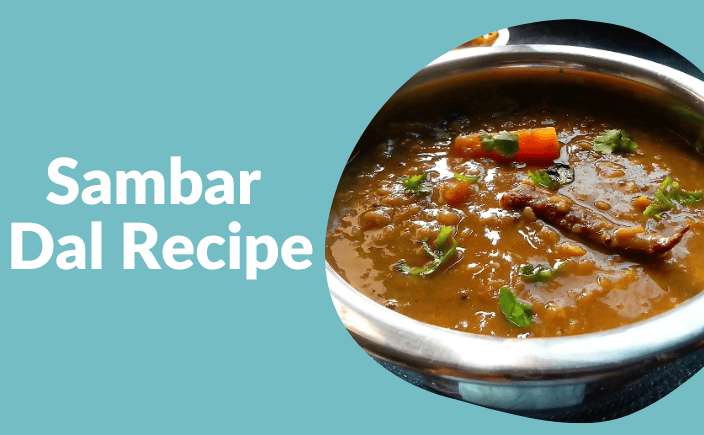Sambar dal, also known simply as sambar, is a popular South Indian dish that is made with lentils, vegetables, and a unique blend of spices. It is a staple in South Indian cuisine and is often served with rice, idli (steamed rice cakes), dosa (fermented rice and lentil crepes), or vada (fried lentil fritters). Read on to know more about easy sambar dal recipe.
About Sambar Dal Recipe
Sambar dal is a delicious and nutritious dish that showcases the vibrant flavors of South Indian cuisine. It is a wholesome and satisfying meal that is enjoyed by people of all ages.
| Time | Difficulty | Serves |
| 30 Minutes | Moderate | 2 |
How To Make Sambar Dal at Home (Step Wise)
Here’s how to make sambar dal in brief, easy steps:-
- Rinse and cook 1 cup of toor dal with 3 cups of water until soft and mushy in a pressure cooker or on the stovetop.
- Chop and prepare your choice of vegetables and set them aside.
- Mix 2 tablespoons of sambar powder with water to form a paste and soak a small lime-sized ball of tamarind in warm water to extract the pulp.
- Combine the cooked lentils, vegetables, tamarind pulp, salt, and sambar powder paste in a large pot, bring to a boil, and simmer until the vegetables are cooked.
- In a separate pan, heat oil or ghee, add mustard seeds, cumin seeds, curry leaves, and dried red chilies, and fry until the mustard seeds splutter. Pour the tempering into the pot with the cooked dal and vegetables, stir well, garnish with coriander leaves, and serve hot.
Preparation for Sambar Dal Recipe
Here’s what you need to be prepared to make this easy sambar dal recipe:
- Rinse and cook toor dal until soft and mushy.
- Chop and prepare your choice of vegetables.
- Soak tamarind in warm water to extract the pulp.
- Chop fresh coriander leaves.
Ingredients for Sambar Dal Recipe
Let’s look at the ingredients for the easy sambar dal recipe:
- 1 cup toor dal (pigeon peas)
- Assorted vegetables (e.g., shallots, tomatoes, carrots, drumsticks, eggplant, pumpkin)
- 2 tablespoons sambar powder
- Small lime-sized ball of tamarind
- Salt to taste
- Water (for cooking dal and adjusting consistency)
- 2 tablespoons oil or ghee (for tempering)
- 1 teaspoon mustard seeds
- 1 teaspoon cumin seeds
- A handful of curry leaves
- 2 dried red chilies
- Fresh coriander leaves (for garnish)
Method/Steps for Cooking Sambar Dal Recipe
Let’s understand how to make sambar dal by following these steps:
Step 1: Rinse and cook toor dal until soft and mushy.
Step 2: Chop vegetables into bite-sized pieces.
Step 3: Mix sambar powder with water to form a paste.
Step 4: Soak tamarind in warm water, and extract the pulp.
Step 5: Cook lentils, vegetables, tamarind pulp, and sambar paste together.
Step 6: Prepare tempering with mustard seeds, cumin seeds, curry leaves, and dried red chilies.
Step 7: Add tempering to the cooked dal and vegetables.
Step 8: Garnish with fresh coriander leaves.
Step 9: Serve hot with rice or South Indian bread.
Any Alternate Way to Make Sambar Dal Recipe
Looking for ways how to make sambar dal interesting? Here, we’ll look at an alternate easy sambar dal recipe that is packed with nutrition and taste.
Step 1: Rinse and cook 1 cup of toor dal until soft and mushy in a pressure cooker or on the stovetop.
Step 2: In a separate pan, heat oil and add mustard seeds, cumin seeds, curry leaves, and dried red chilies for tempering.
Step 3: Add chopped onions, tomatoes, and vegetables of your choice to the pan and sauté until tender.
Step 4: Add the cooked dal to the pan and mix well. Then, add tamarind pulp, sambar powder, salt, and water to adjust the consistency.
Step 5: Let the sambar dal simmer for a few minutes, allowing the flavors to blend. Serve hot with rice or bread of your choice.
Nutritional Value in Sambar Dal Recipe
Here’s an approximate nutritional breakdown for an easy sambar dal recipe:
| Nutrient | Amount |
|---|---|
| Calories | 141 kcal |
| Protein | 7.9 grams |
| Carbohydrates | 25.3 grams |
| Fiber | 5.2 grams |
| Fat | 0.6 grams |
Pro Tips to Make the Best Sambar Dal Recipe at Home
Here are some pro tips on how to make sambar dal recipe at home:
- Tamarind Pulp: To extract maximum flavor from tamarind, soak it in warm water for at least 15 minutes. Squeeze and extract the pulp thoroughly, discarding any seeds or fibers.
- Vegetables: Choose a variety of vegetables to add depth and texture to your sambar dal. Include seasonal vegetables like drumsticks, pumpkin, okra, or eggplant to enhance the flavor profile.
- Sambar Powder: Use freshly ground or high-quality sambar powder for the best taste. If you have the time, you can even make your own sambar powder by toasting and grinding whole spices like coriander, cumin, fenugreek, and red chilies.
- Tempering: Pay attention to the tempering or tadka process. Ensure the oil or ghee is adequately heated before adding mustard seeds, cumin seeds, curry leaves, and dried red chilies. This step adds a burst of flavor to the dish.
- Consistency: Adjust the consistency of sambar dal based on your preference. If you prefer a thicker consistency, simmer the dal for a longer time to allow it to reduce. Add more water if you prefer a thinner consistency.
Health Benefits of Sambar Dal Recipe
Sambar dal recipe, when prepared using nutritious ingredients and cooked in a healthy manner, can offer several health benefits. Here are some of the health benefits provided by this easy sambar dal recipe:
- Protein-rich: Sambar dal is a good source of plant-based protein from the toor dal (pigeon peas), which is essential for muscle growth and repair.
- Nutrient-dense: It contains a variety of vegetables, providing essential vitamins, minerals, and dietary fiber for overall health and digestion. Read more about nutrient-rich foods.
- Low in fat: Sambar dal is generally low in fat, making it a healthier choice compared to some other traditional Indian dishes. Check out our weight loss plans.
- Digestive health: The combination of lentils, vegetables, and spices in sambar dal promotes healthy digestion and may help alleviate digestive issues.
- Balanced flavors: Sambar dal incorporates a blend of spices, such as turmeric, coriander, and cumin, which not only add flavor but also offer potential anti-inflammatory and antioxidant benefits to support overall well-being.
Tips to Limit the Calorie in Sambar Dal Recipe
Here are some tips on how to make sambar dal recipe with fewer calories:
Step 1: Use less oil: Reduce the amount of oil or ghee used for tempering. Instead of frying the spices in a generous amount of oil, use a non-stick pan or cooking spray to sauté them with minimal oil.
Step 2: Choose leaner cuts of vegetables: Opt for low-calorie vegetables like onions, tomatoes, green beans, spinach, or bottle gourd. These vegetables provide nutrition while keeping the calorie content lower.
Step 3: Reduce or skip coconut: Coconut is often added to sambar for richness, but it also adds calories. Consider reducing the amount of grated coconut or using desiccated coconut sparingly, or skip it altogether if you prefer.
Step 4: Control portion sizes: Keep an eye on portion sizes to moderate calorie intake. Serve yourself a reasonable portion of sambar dal and pair it with a generous serving of vegetables or a side salad to create a balanced meal.
Step 5: Limit added fats: Be mindful of the quantity of oil or ghee used for tempering. You can also experiment with alternative cooking methods such as steaming or baking the vegetables instead of sautéing them in oil.
FAQs
What is the cooking time for the Sambar Dal recipe?
It takes around 30 minutes to make this easy sambar dal recipe.
What’s Different in the Sambar Dal Recipe by Livofy?
Sambar dal recipes can differ in terms of ingredients, preparation methods, and flavors. Each recipe may have its own unique combination of spices to create delicious and nutritious sambar dal. The complexity and cooking time can vary, allowing you to choose a recipe that fits your schedule. Trying out different recipes will help you discover your preferred version of sambar dal that suits your taste buds and dietary preferences.
Is Sambar Dal healthy?
Sambar dal is a nutritious dish as it contains protein, vitamins, minerals, and dietary fiber from lentils and vegetables. It is a wholesome and balanced meal that supports overall health and provides energy. However, the overall healthiness of sambar dal depends on the ingredients used, portion sizes, and cooking methods.
How many calories does the Sambar Dal recipe have?
The calorie content of sambar dal can vary based on the specific ingredients and proportions used. On average, a serving of sambar dal (approximately 1 cup) may contain around 150-200 calories. However, it’s important to note that this is an estimate, and the calorie content can vary depending on the specific recipe and serving size.
How to make Sambar Dal recipe interesting?
Here’s how to make sambar dal recipe interesting:
- Experiment with spices: Add a pinch of asafoetida (hing), fenugreek seeds, or roasted cumin powder to enhance the flavors and give the sambar a unique twist.
- Add a touch of tanginess: Squeeze a bit of lemon juice or sprinkle some amchur powder (dried mango powder) to add a tangy element that can elevate the taste of the sambar dal.
Are there any side effects of Sambar Dal?
Sambar dal is generally safe to consume for most individuals. However, it may cause flatulence or gas due to the presence of certain carbohydrates. Some people may also experience bloating or digestive discomfort if they have a sensitivity to legumes. It’s important to cook the dal thoroughly and ensure proper soaking to minimize any potential side effects. If you have specific dietary restrictions or concerns, it’s best to consult with a healthcare professional.
How to make Sambar Dal recipe with maximum flavor?
Here’s how to make sambar dal recipe with maximum flavor:
- Roast and grind whole spices like coriander seeds, cumin seeds, fenugreek seeds, and red chilies to make your own fresh sambar powder.
- Enhance the taste by adding a tadka or tempering of mustard seeds, curry leaves, dried red chilies, and asafoetida to infuse the dal with aromatic flavors. Additionally, adding a dollop of ghee at the end can add richness and depth to the dish.
How to make Sambar Dal with delicious chutneys?
Here’s how to make Sambar Dal with delicious chutneys:
- Pair the Sambar Dal with coconut chutney made from freshly grated coconut, roasted chana dal, green chilies, and a hint of tanginess from tamarind or lemon juice.
- Another tasty option is tomato-onion chutney, prepared by sautéing tomatoes, onions, garlic, and spices, then blending them into a smooth and flavorful chutney. Serve these chutneys alongside Sambar Dal for a delightful combination of flavors. Check out our mint chutney recipe.









